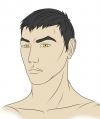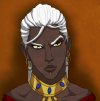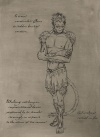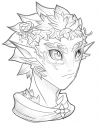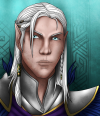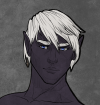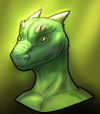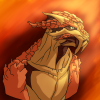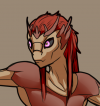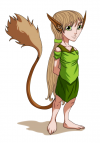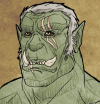More actions
Aloria is brimming with a plethora of races scattered all about the lands and seas alike. Alorian races are all incredibly diverse and individually unique, spanning from the prosperous Humans and their excellent ability to expand, the Maiar that rise to the surface or dwell deep beneath the water, and the Mekett, whose strong culture has only recently surfaced from the deepest pits underground. What makes a race different from any other beast is primarily its sentience; a race has the ability to think, communicate, and is able to be aware of itself, while a beast cannot always do that. Races are playable on MassiveCraft while beasts are typically not, and when referenced, race names are capitalized and beast names are left lowercase. For example, a troll is a beast, while an Orc is a race.
Human
|
From the warm coastlines of Daendroc to the icy ranges of New Ceardia, the Ailor Humans rule supreme in Aloria. Peaking the social, political, and economic ladder, the Ailor, often referred to as Humans, consider themselves to be the height of society (to the disdain of the other civilized races). In the beginning, they existed as barbaric peoples in Ceardia. To their eventual rise and expansion outward, the Ailor Humans have proven to be the most progressive and aggressive people of Aloria, having conquered an assortment of populations and nations. The most prominent of these conquerors are those of the Regalian Empire, perhaps one of the largest ruling bodies in Aloria. Sometimes considered the inheritor realm after the fall of the Elven Empire, the Regalian Empire proves to essentially be the center of Alorian life and activity, the empire’s capital sitting as a cultural, political, and economic center. While maintaining a similar build to the other Human races of Aloria, the Ailor tend to be the most diverse. Ranging from paler complexions to dark tans, Ailor Humans feature a wide spectrum of physical appearances and culture, having been a widespread people throughout Aloria. Along with their unique physical aspects, the Ailor’s culture, customs, and traditions vary even more. |
|
Quiet and elusive, the Ch’ien-Ji are no new people to the world of Aloria. These seafaring folk are masters of the sail, using their unique prowess in magical arts to help with their maritime efforts. Proud, peaceful, and wise, the Ch’ien-Ji grew rapidly from their homeland of the Yang-Tzu Isles, going onwards to establish an early trade empire. However, their progression into what could’ve been a magnificent society has been stunted by the aggressive Wulong, a beastly people who shared the isles with the Chi’en-Ji. Many years of bloody war and conflict polluted the isles, and copious amounts of Chi’en-Ji fled their homeland in pursuit of better lives. Being a beacon of opportunity and a fresh start, the city of Regalia houses the shorter Humans, regardless of their peculiar culture and their distant native land. Typically, Regalians treat them as first class citizens, despite their unfamiliar oriental culture. The rituals and habits of these people tend to be endearing to those who are native to Regalia, though they tolerate the behavior as a cultural anomaly. Chi’en-Ji typically have olive or tan skin tones, with black hair and golden eyes to compliment it. Their language and naming patterns are usually based off real-world Korean, Chinese, or Japanese. |
|
Qadir hail from the vast, expansive deserts of Farah'deen, and their worship of the sun and its presence is predominant though most of their culture as their main religion. Despite being a sub-race of Humans, many Qadir are genetically closer to the mysterious and extinct Seraph, often seen with golden eyes and, for Azir Qadir in particular, hair whiter than any quartz. These desert dwellers hold a range of darker toned skins, and their homelands host an impressively guarded Qadiriyye, ruled by a monarch style system of government. Many Qadir are more inclined to skills with Magic while others are naturally adept fighters, often attributed to long limbs and natural athletic forms. Skillful pirates and slave traders, Qadir have mastered the trade of other races, and slaves make up a large part of Qadir society because of this. Despite disagreements existing between the Regalian Empire government and the Sultanate, Qadir can be seen on the streets of Regalia as both visitors and Citizens. |
|
Stocky and short, and practical and innovative, the Dwarves that most commonly inhabit the surface of Ellador are a proud race with a talent for battle, metalworking, and invention—this is often boasted by the Dwarven airships that bumble about Ellador’s skies. Upon being forced to the surface by the Dakkar invasion, Dwarves have begun to work their way into other societies, and are not an uncommon sight in Regalia. Since arriving, Dwarves have become recognised as second-class citizens of the Regalian Empire, and crimes against them are expected to be punished properly. While Dwarves are generally accepted among most Humans, nicknames such as “Stout Folk” are not uncommon, as even the tallest Dwarf will likely fail to reach five feet in height. However, Dwarves are typically not much lighter than a human, despite what one would expect. They often boast a wider, more built physique, which can make them even heavier than your average Human. With a strong Elladorian heritage, their skin tone is as one would expect: a pale to a fair complexion. Hair colors are similar to that of humans, with red, black, brown and occasionally blonde being the most common. |
|
Depending on your perspective, the ape-like Wulong are either the cruelest of savages or the embodiment of uninhibited, natural thought and action. They are made fearsome by their physical presence and more exotic because of their tails and thick tufts of hair, but it is the mind of the Wulong that makes them truly dangerous: they are emphatically blind to the suffering of other races and motivated only by the pursuit of that which pleases them. Much taller and stronger than Ailor, they move with the same raw and unrestrained power that characterizes every facet of their life. Wulong hunt, dance, fight, and even appreciate the natural world with an unmatched, if somewhat scattershot, enthusiasm. On the rocky and barren islands of the northern Yang-Tzu archipelago this subrace of Humans lived in primitive isolation until they encountered their southern neighbors, the Ch'ien-Ji. Centuries of war have followed those first bloody territorial disputes, affecting every area of Wulong tribal life and even driving some of their numbers beyond the archipelago. Those who have found their way to Regalia may find themselves unsuited to a place where restraint and reason secures one’s place in society. At best, citizens and guards will keep a close and suspicious watch, but the reaction of any Ch'ien-Ji may be far more explosive. |
Florae
|
From the extensive forests to the rising cities reborn from the destruction of the Elven Empire, the Yanar can be seen about Daendroc and other great holdings of nature, tending to their groves and gardens as their lady Estel has instructed them. Well-known for their plantlike appearance, these humanoids grow flowers, bark, fungus and fruit seemingly out of (or in place of) their flesh. Yanar are elegant and pure in their youth, but withered and decomposing in their older ages, towards sixty years. Their hair and eye colors reflect the norm of the Elves; that of golden, green, blue and brown eyes, to match brunette, black, and blonde hairs (if they have hair). As mentioned before, the Yanar all bear some resemblance to a plant, whether it be fruit or vegetation. These flowery folk were born when Estel saw the need to warn the Altalar within the Elven Empire of the most recent Void Invasion. But the Altalar had strayed too far from nature, and they could not understand the Yanar. When the Shendar did come, they were able to infect the plantlike people with a mildew substance, slowly deteriorating the physical and mental states of the host until he or she turned into a dark entity of Behaesal: A corrupted Yanar. Following this, the Yanar began slowly being incorporated into Elven society, splitting with the Yanar at the Elven civil war. Now, they are renowned for their healing abilities using their general knowledge of the plantlife of Aloria, serving Regalia in that aspect and being treated with according respect. |
Nelfin
|
Upon a first glance at the husks of the great city of Rie, one would hardly think that only four hundred years ago, it was occupied by millions of Altalar. The original, as well as most populous subrace of Nelfin, the Altalar once ruled the Alorian stage as a great power with their magic might and their overzealous expansionism. They most frequently have blonde hair, and are often seen with brown, blue, or green eyes. This is all accompanied by their incredibly angular faces with equally pointed ears. Most Altalar enjoy intellectual provocation, taking scholarship, magical pursuit, and politics more than most other races, utilizing their intellectual superiority and longevity to become the ultimate mages. Altalar schools often double as temples devoted to the Elven Goddess known as Estel, a mysterious female figure thought to hold complete hegemony over all of Aloria. Rather than fighting or caring for nature, the Elves of the city enjoy a life of decadence, delving into personal pleasures rather than bettering the world around them. Prior to the Cataclysm, the Elven Empire ruled as one of Aloria's highest organized powers. They enslaved many races, such as the Ailor, Tigrans, and Slizzar. This Empire survived until the most recent Void Invasion, where nearly most of the population would be wiped out. Following this, a subsequent Orc invasion cut the remaining population in half, hammering the final nail of death into the coffin known as the Elven Empire. Today, the Altalar of Regalia begrudgingly acknowledge the Ailor supremacy. They shun most other races, but out of convenience, they acknowledge the military might of the Regalian Empire. This doesn’t stop the Altalar from holding the belief that the Nelfin will rise again and retake the mantel of their fallen Empire. Until then, the Elves shall bide their time and wait, perfecting their arcane arts and expanding their knowledge of Aloria. |
|
An elusive and mysterious race, the Isldar prefer to remain shut off from the rest of the world, instead weaving their way into Elladorian legends. This Nelfin subrace holds a central belief that Dragons gave life to the world. They say the more elusive Isldar remain sheltered away, tending to the remaining Frost Dragons and Frostweaver. Thanks to their icy seclusion, this subrace bears very similar features, including pale, blue-tinted skin, blue eyes, and white hair. Naturally, Isldar share the typical angular features and pointed ears of other Nelfin. As the existence of most Isldar revolve around their religious beliefs, any Isldar who leave the hold are often considered traitors or heretics for violating religious beliefs. Aside from these beliefs, Isldar appreciate song and music but generally lack the intellectual decadence of other Nelfin sub-races. Many Isldar cannot read or write, speak solely Nelfin or broken Common, and are assumed dependant on magic. Other aspects of Isldar culture and beliefs still remain a mystery as the Nelfin sub-race continues to guard its society, embedded in the worship and fear of the ancient Frostweaver dragon. |
|
With a cloud cast over them by the Archdemon Behesael, the Shadow Elves, or Shendar, were once normal Elves who fought alongside the goddess Estel in the third Void Invasion. As they succumbed to evil, they soon grew to be their own distinct sub-race. When they began to change, they turned into outcasts, and most gravitated toward their Shadow Council in Void Worship and heresy. But the instability in Daendroc eventually crippled them. The Orcs invaded, the council fell, and Shadow Elves spread far across the continent. With their distinction from Altalar, their appearances changed. Their skin turned an ashy gray, and their normally healthy hair faded to a shocking white. However, Shendar are still capable of having all the eye colors a normal Elf may have. Nowadays, Shendar are usually possessed by demons at birth, and live in heretical tribes scattered about Daendroc. Their culture is steeped in tradition and magic. In Regalia, they are outlawed for their deep history in Void Worship, but a rare Shendar who has not been possessed will have a chance of safely walking the streets lawfully. Unfortunately, tolerance is low for these fair-haired Elves, and Shendar will often find themselves victims to hate crimes, hardly controlled by Regalian guards because of their deep disdain for the race. A Shendar must be charismatic and make good friends if they want to survive the streets of Regalia. Otherwise, they may simply disappear. |
|
The Dark Elves of Drowda have a history that reaches back to the conclusion of the third Void Invasion and the resulting Cataclysm. Once normal Altalar Nelfin (or Elves) who fought avidly for their goddess Estel, their aggressive and militaristic nature and obsession with demons made those around them uneasy. Even when the demons became entrapped on the Forbidden Continent and Aloria was met with relative safety, these people insisted that more needed to be done. The Drowdar Elves were cast from society due to their frightening adamance to completely destroy Behesael’s army once and for all. Eventually, these Dark Elves flocked to the Forbidden Continent to finish the work they had tried to convince their fellow Altalar to do. The contamination from the continent colored their skin an alien blue and their hair silvery white. To this day, the Drowdar elves predominantly live their lives in citadels on the faraway continent, battling off the torrent of demonic armies and the Shendar elves that roamed the land. While very few are seen to leave Drowda, those that do were either exiled or left by choice. They are treated with suspicion from the rest of the world. Regalians typically grow uncomfortable around dark elves, and they’ll most often be treated as if they were unpossessed Shendar, despite the Drowdars’ deep hatred for their grey-skinned cousins. Certainly being exposed to so much void contamination had its drawbacks. Anything from the Forbidden Continent couldn’t be good news. Yet the Drowdar knew that their minds were clear and their cause was pure. They would be the saviors of Aloria. |
Dargon
|
No race bears as extensive a history of slavery as that of the Tigran race; once all beastial creatures of the wild, Tigrans are known for their resilience in the face of adversity. A prime example of this can be seen in the transformation of some Tigrans into those who have become known as Tamed. These Tigrans have gained a sophistication and a loss of instinctual responses; they are often the most intelligent and most tamed of the species, often finding themselves in self-servitude not too unlike their ancestral history of slavery. Large and Small Ferals, on the other hand, are Tigrans resembling large and small wild cats which often travel in tribes. They are seen as savage and are more often spotted in the wild than not. The most unspeakable and rare subrace of Tigran is known as the Degenerate. These creatures walk on four legs and have no intellectual capabilities. These sub-races have developed in response to the slavery the race has been subjected to through the years. Originating in Ithania, Tigrans were initially discovered by Elves who proceeded to hunt Tigrans for sport and enslaved those Tigrans bearing intellectual capabilities; at one point, ninety-five percent of the Tigran race found themselves enslaved to Daendroquin Elves. At the pivotal collapse of the Elven Empire, Tigrans were able to escape and have since evolved into a wandering race with no true culture of their own, often seeking to adapt to the cultures around them. Those that have found their way to Regalia have tried to integrate into the community as best as possible, having found that they bear little to no rights and hence little protection within the city. More often than not Tigrans indenture themselves as servants to the wealthy and the nobility, not straying too far from their ancestry. |
|
One is likely to mistake an Ur for a bear standing upright, more so if seen through the falling snow on some frozen plain. Their ursine bodies are typically muscular and bulky, often with layers of insulation that keep them safe in climates that could kill a Human even when wrapped in furs. However, that same observer might also notice the totems and jewelry that speak of reverence for their ancestors and of the great spirit Svelarun. And while the incorporation of their belief system into everyday life has helped earn them a somewhat unfounded reputation as gentle giants, the Ur have been engaged in a religious and territorial, species-wide war with the Thylan. That conflict has shaped nearly all of Ur history over the past few centuries, driving them to form large tribal confederacies where they’d previously traveled nomadic routes alone or in small groups. Some have gone further, spreading out across Aloria in search of allies that may help turn the war in their favor. An Ur traveling as far as Regalia should always wear clothing, lest they actually be mistaken for a wild bear. And while capable of defending themselves, they should watch their backs—their furs are still worth quite a lot in Regalia. |
|
There was a time when all animals, races, and even plants dreamed together in the Great Sleep until they each woke into creation. At least, that’s what the canine Thylan race believes, and that idea of universality can be seen in the way they work cooperatively or even in the compassion they often show towards other races. Together, packs of Thylan survive in tribal villages or painted caves, and the call of their wind instruments carries far on the currents blowing across the cold hills and plains. Those who have been lost are honored with offerings and totems in sacred catacombs, but ever since the race migrated north to escape the ravages of the cataclysm, those sites have been desecrated and repeatedly gutted by their enemies. The thinner coats of the Thylan push them southward to escape the unimaginably cold winters of Jorrhildr, but the Ur remain and hibernate within the holy places of the Thylan. Centuries of war have ensued. The unimaginable loss of life, as well as the scarcity of resources that so often follows prolonged conflict, has pushed some Thylan to seek refuge within Regalia. There they do not enjoy citizenship, nor the rights that would accompany it, but relative safety for themselves and their pack mates may be found. |
Naylar
|
The grand Chrysant Kingdoms of Hadar fell eleven years ago, when the Chrysant War was concluded and a large part of the kingdoms left deserted. Numerous Naylar towns and cities fell to the Regalian Empire, leaving a dent in their numbers and putting them in an uncomfortable place on Regalian land. Naylar, with their scaly bodies and reptilian appearances, are not outlawed in the Holy City of Regalia, but heavily frowned upon. The destruction that came from the recent Chrysant War has left its mark on many involved, and with the strange behavior of the previous Naylar empress, Mikuni, who unified the kingdoms into a grand empire and fell with her campaign, plenty of those in Regalia are hesitant to trust these people. Most Naylar and Ailor are old enough to have fresh memories of the war, and many who fought are still alive today. The difference between Ailor humans and Allar are drastic. Allar typically have green, gray, or black scales that coat their bodies, eyes on the sides of their heads, digirad legs, and the occasional horns. This can make them appear rather suspicious upon first glance, though their demeanors can be as varied as any sentient race. Allar are the most widespread of the Naylar races, giving them a small sense of entitlement. But in Regalia they are treated as dangerous beings, and many Allar are subject to hate crimes from fearful citizens. The Chrysant War was the reason so many loved ones met terrible ends, all because one Naylar tried to unify her people against the Regalian empire and steal the happiness and life from those more fortunate than her. |
|
From the depths of Gana-Isha, the lizard-like Dakkar rose in a blaze of violence and righteousness. For thousands of years they stayed within their fiery realm, content with bleeding and killing amongst themselves in the name of their war-like god Hael. This changed when the Dwarves dug into a temple devoted to Hael while their most sacred of ceremonies, the Rashpur, was taking place. The result was a holy crusade against the Dwarves that very nearly wiped them from the depths of Aloria. When the Dwarves fled to the surface, the Dakkar followed. But when they met the barrier between earth and sky, they found this new land most agreeable to them. What followed was a splintering in the belief system of the Dakkar, causing civil war and strife within. Their crusade against the Dwarves forgotten, small amounts Dakkar fled, intent on escaping their more zealous brothers and finding a new life upon the surface. To the races already living there, these strong, warrior like lizard people with their seemingly stone skin are often met with adversity or fear due to their natural and religious inclinations towards violence. While somewhat of a rare sight, within Regalia they are tolerated as much as their cousins, the Allar and Slizzar. Beatings from impassioned Dwarves as the Violet Order standby pretending to see nothing is commonplace for any Dakkar living there. Regardless, the Dakkar continue to surface from the depths below, intent on discovering a new life or hunting heretics that dare to diverge from the 'true' way of Hael. |
|
As mysterious and secretive as common snakes, the Slizzar are the rarest race in Aloria; only a few thousand still exist in the entire world. Slizzar were once abundant in the Essa Empire and before, though war and racial cleansing seriously diminished their numbers. Slizzar are distrusted, yet alluring to most other races due to their inherent shape-shifting abilities. Slizzar continue to do what they do best nowadays: worming their way into the trust of individuals in power, and then using that to better themselves. They can often be seen as courtesans and advisers, but are also successful assassins or spies. Few can be found in the open, though all of them travel back to Ssasrakand every year during the solar eclipse day. |
Mekett
|
The Circci have awoken to a world that has moved on, a place where the thriving civilization their ancestors built has been forgotten. Lost too is the physical form of the Meraic of old, for the Circci who emerged from the earth in their stead have been transformed by their time in stasis into an insect-like species with features alien to the other inhabitants of Aloria. The Circci serve the Great Purpose, a mission left to them by their ancestors on tablets and scriptures. While less than twenty years have passed, the invasive Circci have already secured a foothold, forming new hives in the ruins of the recently fallen Naylar empire. Even in Regalia they may be found, often in a delegation of Circci accompanied by servants and bodyguards. Their position within that Human empire is fragile at best. Barely tolerated, often feared, and physically disturbing, Circci must remain very cautious, for now. |
Kleinfolk
|
The Lampar are a peaceful race of Kleinfolk inhabiting the smaller islands of the Evokai island groups, somewhere off the southern coast of Farah’deen. To many other races around the world, the Lampar are a race of short vermin people who scavenge the trash and leftovers of the other races and generally make a living in any hole and crack they can find. This behavior is often detrimental to their standing in society, especially in Regalia, where they bring disease and damage buildings by creating homes in the foundations. Despite their reputation however, Lampar can be very good company. They are naturally peace and fun loving creatures who always have a smile on their faces. Their behavior can often be considered as comical as well, leading to many of them being employed in circuses and street performances. The Lampar only very recently made an entry onto the world’s stage due to the relative isolation of their homeland in the Silent Ocean between the known world and Muird. Still, their curiosity can carry them across the world, much to the enjoyment or irritation of the other races. |
|
The Rashaq are a race of feline-like Kleinfolk inhabiting the central islands of the Evokai island groups, somewhere off the southern coast of Farah’deen. To many other races around the world, the Rashaq are described as a mixture between Ailor and Tigran given Dwarven height. This, however, falls their race short, as the Rashaq have some of the most unique cultural inclinations in Aloria, with a deep and rich history and folklore. The Rashaq, much like their Lampar cousins, are often seen as an exotic anomaly in Regalia, performing in circuses or acrobatic street acts due to their unnatural agility. Rashaq are in many ways still very feral, but are also incredibly social people, enjoying large, extensive families and warm bonds with local community members. Their ability to accept anyone as a friend or companion, similar to the same trait of the Lampar but more sophisticated, makes them a happily received guest despite their odd behaviors. Rashaq venture out into the world looking for fortune, much like the Lampar they are beset with curiosity, but more curiosity born out of greed and desire for wealth. |
Gorr
|
Large, hostile, and in possession of tusks capable of goring an enemy, Orcs have earned their reputation as fierce and intimidating warriors. Even their young are left to fight it out in ‘pits’ where litters are reduced to only the strongest few survivors. Throughout their lives such strength and ability in battle will always determine their social status. Not surprisingly, tribes tend to maintain distance from one another, and even then, infighting has always limited the growth of any large scale Orcish empire. Physically, they are sometimes called grotesque, perhaps due to their gray or green skin, imposing musculature, and less than sunny disposition, but that hasn’t deterred other races, such as the Humans, from employing them to do the heavy, dangerous work in battle. But whether recruited into war or self-motivated, theirs is a history defined by conflict. In particular, Orcs have been engaged with the Elves ever since first fleeing the increasingly poisoned air of their homeland, Guldar. Once they even brought the Elven Empire to its knees in a war culminating with the ‘Big Boom’ that wiped the capital of Ríë off of the map. |
Mer
|
Under the oceans of Aloria, the various types of Maiar make their homes in towns and cities built by the numerous castes of Maiar society under the waves. With the higher rings of the Maiar socioeconomic ladder going as far as to cannibalize their slower and unintelligent cousins, Maiar have very unique and interesting histories of evolution and devolution with changes in intelligence and social status crossing as quick as just a few generations. Despite their awkward inability to stay above water for more than a day for any of their castes, Maiar are found in almost every region of ocean in the world, and Maiar cities are growing slowly into larger and more grandiose proportions. Resembling many sorts of fish and ocean life, Maiar are slowly becoming a more known presence in Regalia and other parts of the world. While most opinions of Maiar from other races is a bit poor, Maiar are free to walk the streets of Regalia and even have a small pool in the tavern for their visitations considering the shortcomings that accompany being a water-based race. Some Maiar have gone as far as to serve high ranking nobility, making themselves useful in naval tactics and espionage. The average Maiar won’t find themselves going this far, due to the riots that typically ensue when a non-human gains land. However, opportunities for advancement are abound for the crafty or more intelligent of their species. |
| ||||||||||||||||||||||

